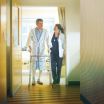(Press-News.org) A new UCLA-led study shows that a blood test commonly used to determine whether heart transplant recipients are rejecting their new organ can also predict potential rejection-related problems in the future.
Reporting in the online edition of the peer-reviewed journal Transplantation, researchers demonstrate how the AlloMap test, which uses a blood sample to measure changes in the expression of roughly a dozen genes, can be used over a period of time to assess the risk of dysfunction or rejection of a transplanted heart — months before such an event may occur.
"For the first time, we can use genomic testing over multiple patient visits to go beyond intuition to understand not just how patients are doing now but how they are likely to be a few months from now," said Dr. Mario Deng, medical director of UCLA's Integrated Advanced Heart Failure–Mechanical Support–Heart Transplant Program and the study's principal investigator. "It's another step toward personalized medicine."
The discovery that transplant recipients' white blood cells contain this prognostic information on rejection, independent of how their transplanted heart may be functioning currently, could potentially improve care and outcomes, the researchers said. The findings represent a significant step in the movement toward using genomic-based testing to predict future clinical events and bolster the importance of similar tests being developed for recipients of other organs.
In the U.S., approximately 2,000 patients receive lifesaving heart transplants each year, and monitoring their immune systems for signs of rejection is a critical part of follow-up care. Until recently, however, the only way to diagnose rejection was through a heart-muscle biopsy, a painful and potentially risky procedure in which a heart catheter is inserted through a vein in the neck.
That changed with the development of the AlloMap gene-expression profiling test, which received clearance from the Food and Drug Administration in 2008. The test is now routinely used by a majority of U.S. heart transplant centers to monitor low-risk patients during follow-up care, resulting in a substantial reduction in the number of biopsies.
AlloMap, which is based on research Deng led in conjunction with more than a dozen of the largest U.S. heart transplant centers and the Brisbane, Calif.–based biotech company XDx, measures the expression levels of 11 genes from a patient's blood sample, each of which is known to be associated with rejection risk.
"The AlloMap was the first FDA-cleared test allowing transplant centers to rule out rejection at the time of the visit," Deng said. "But until now, it has never been used to predict future events."
The current study is based on data originally collected by leading transplant centers and published in the New England Journal of Medicine in 2010. For that study, 600 heart transplant recipients were randomly assigned to be monitored for potential episodes of rejection either through routine biopsy or through the AlloMap test. The study found that AlloMap was equally as effective as biopsy at detecting rejection or dysfunction, and it resulted in increased patient satisfaction because it was less invasive.
The new study demonstrates for the first time the ability of the AlloMap test, when used over time, to predict future events.
Deng and colleagues noted that using gene-expression profiling to predict the future likelihood of patients experiencing rejection-related problems with their transplanted heart could change the way such patients are treated.
For example, those deemed to be at low risk for adverse events could be given lower doses of immunosuppressive drugs, which could reduce the significant side effects. On the other hand, patients found to be at high risk could be evaluated at shorter time intervals to determine the causes of the test-result variability, specifically to rule out rejection.
As of now, there are no similar tests to monitor the potential for rejection in other types of transplanted organs, but Deng said that active collaborative and multidisciplinary research programs at UCLA and elsewhere are working to bring genomic testing to these fields.
INFORMATION:
Deng received research support and consultancy fees from XDx.
For more news, visit the UCLA Newsroom and follow us on Twitter.
Blood test serves as 'crystal ball' for heart transplant patients, UCLA-led study finds
2014-02-18
ELSE PRESS RELEASES FROM THIS DATE:
The thousand-droplets test
2014-02-18
This news release is available in German. An almost infinite number of complex and interlinked reactions take place in a biological cell. In order to be able to better investigate these networks, scientists led by Professor Friedrich Simmel, Chair of Systems Biophysics and Nano Biophysics at the Technische Universitaet Muenchen (TUM) try to replicate them with the necessary components in a kind of artificial cell. This is also motivated by the thought of one day using such single-cell systems for example as "nanofactories" for the production of complex organic substances ...
Nanodiamond-embedded contact lenses may improve glaucoma treatment
2014-02-18
By 2020, nearly 80 million people are expected to have glaucoma, a disorder of the eye that, if left untreated, can damage the optic nerve and eventually lead to blindness.
The disease often causes pressure in the eye due to a buildup of fluid and a breakdown of the tissue that is responsible for regulating fluid drainage. Doctors commonly treat glaucoma using eye drops that can help the eye drain or decrease fluid production.
Unfortunately, patients frequently have a hard time sticking to the dosing schedules prescribed by their doctors, and the medication — when ...
Ticks may cause double trouble, Stanford scientists find
2014-02-18
As winter turns to spring and many Northern Californians plan outdoor adventures, a mysterious, potentially debilitating threat looms.
A newly recognized human pathogen with unknown health consequences has been found to occur over a large part of the San Francisco Bay Area. A study to be published in the March issue of the journal Emerging Infectious Disease details how researchers including Dan Salkeld, a research associate at the Stanford Woods Institute for the Environment, found the bacterium, Borrelia miyamotoi, as well as Borrelia burgdorferi, the bacterium that ...
What cooperation and conflict in an insect's society can teach us about social acceptance
2014-02-18
VIDEO:
This video shows a female wasp marked with pink paint that was a recently accepted non-nestmate who became a subordinate worker. A resident female flies in and forces the newly...
Click here for more information.
Coral Gables, Fla. (Feb. 17, 2014) -- Ants, wasps and humans live in highly complex societies. Our organizations share some basic features of group life, like individuals trying to find the balance between cooperation and conflict. Understanding what factors are ...
UCI study finds specific genetic cue for sudden cardiac death syndrome
2014-02-18
Irvine, Calif., Feb. 18, 2014 — UC Irvine researchers have found a specific genetic flaw that is connected to sudden death due to heart arrhythmia – a leading cause of mortality for adults around the world.
While a number of genes have been linked with arrhythmias, UC Irvine's Geoffrey Abbott and his colleagues discovered that the functional impairment of a gene called KCNE2 underlies a multisystem syndrome that affects both heart rhythm and blood flow and can activate chemical triggers that can cause sudden cardiac death.
"With these findings, we can now explore improved ...
RealeyeZ Takes 3D Animation to the Next Level with RealHD MooV
2014-02-18
Online shoppers are accustomed to viewing consumer products in 360 degrees. Now RealeyeZ3D is taking the power of RealHD to the next level. Their new product, RealHD MooV, offers moving features that are not available elsewhere in video or 3D marketing and merchandising.
"RealHD Moov uses the MPEG-4 movie format," says company founder and CEO, Ofer Rubin. "It is compatible with Apple and all other platforms and responsive to all screen sizes. Together with its new scalability. It will look like retailers spent tens of thousands of dollars on high-end TV ...
Ion beams pave way to new kinds of valves for use in spintronics
2014-02-18
Researchers at the Helmholtz-Zentrum Dresden-Rossendorf (HZDR) have tested a new approach to fabricating spin valves. Using ion beams, the researchers have succeeded in structuring an iron aluminium alloy in such a way as to subdivide the material into individually magnetizable regions at the nanometer scale. The prepared alloy is thus able to function as a spin valve, which is of great interest as a candidate component for use in spintronics. Not only does this technology use electron charge for purposes of information storage and processing, it also draws on its inherent ...
Study uncovers surprising differences in brain activity of alcohol-dependent women
2014-02-18
BLOOMINGTON -- A new Indiana University study that examines the brain activity of alcohol-dependent women compared to women who were not addicted found stark and surprising differences, leading to intriguing questions about brain network functions of addicted women as they make risky decisions about when and what to drink.
The study used functional magnetic resonance imaging, or fMRI, to study differences between patterns of brain network activation in the two groups of women. The findings indicate that the anterior insular region of the brain may be implicated in the ...
85 percent of heart attacks after surgery go undetected due to lack of symptoms
2014-02-18
Without administering a simple blood test in the first few days after surgery, 85 percent of the heart attacks or injuries patients suffer could be missed, according to a study in the March issue of Anesthesiology. Globally, more than 8 million adults have heart attacks or injuries after surgery every year, and 10 percent of those patients die within 30 days.
The study suggests a new diagnosis, Myocardial Injury after Noncardiac Surgery (MINS), would be useful to physicians because of its broader definition from what is traditionally used to diagnose heart attacks now. ...
Chance of falling after knee replacement not increased by regional anesthesia
2014-02-18
Two types of regional anesthesia do not make patients more prone to falls in the first days after having knee replacement surgery as some have previously suggested, according to a study based on nearly 200,000 patient records in the March issue of Anesthesiology.
Regional forms of anesthesia – spinal or epidural (neuraxial) anesthesia and peripheral nerve blocks (PNB) – which only numb the area of the body that requires surgery, provide better pain control and faster rehabilitation and fewer complications than general anesthesia, research shows. But some surgeons avoid ...






